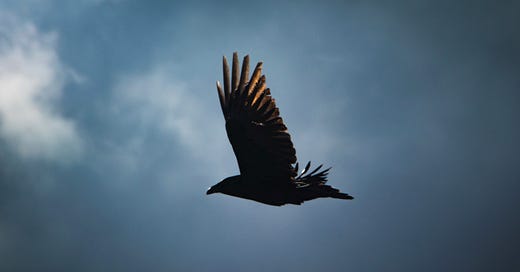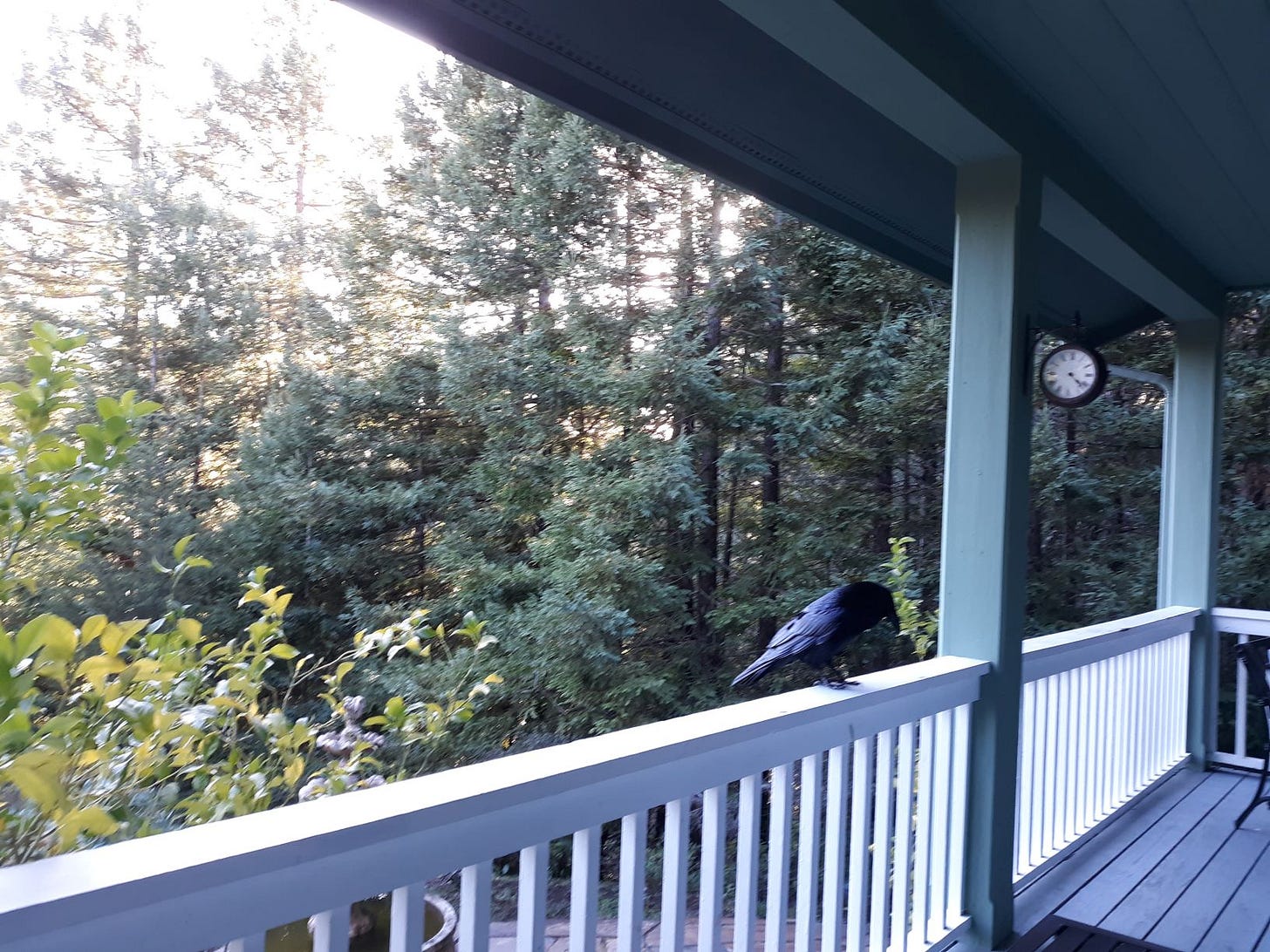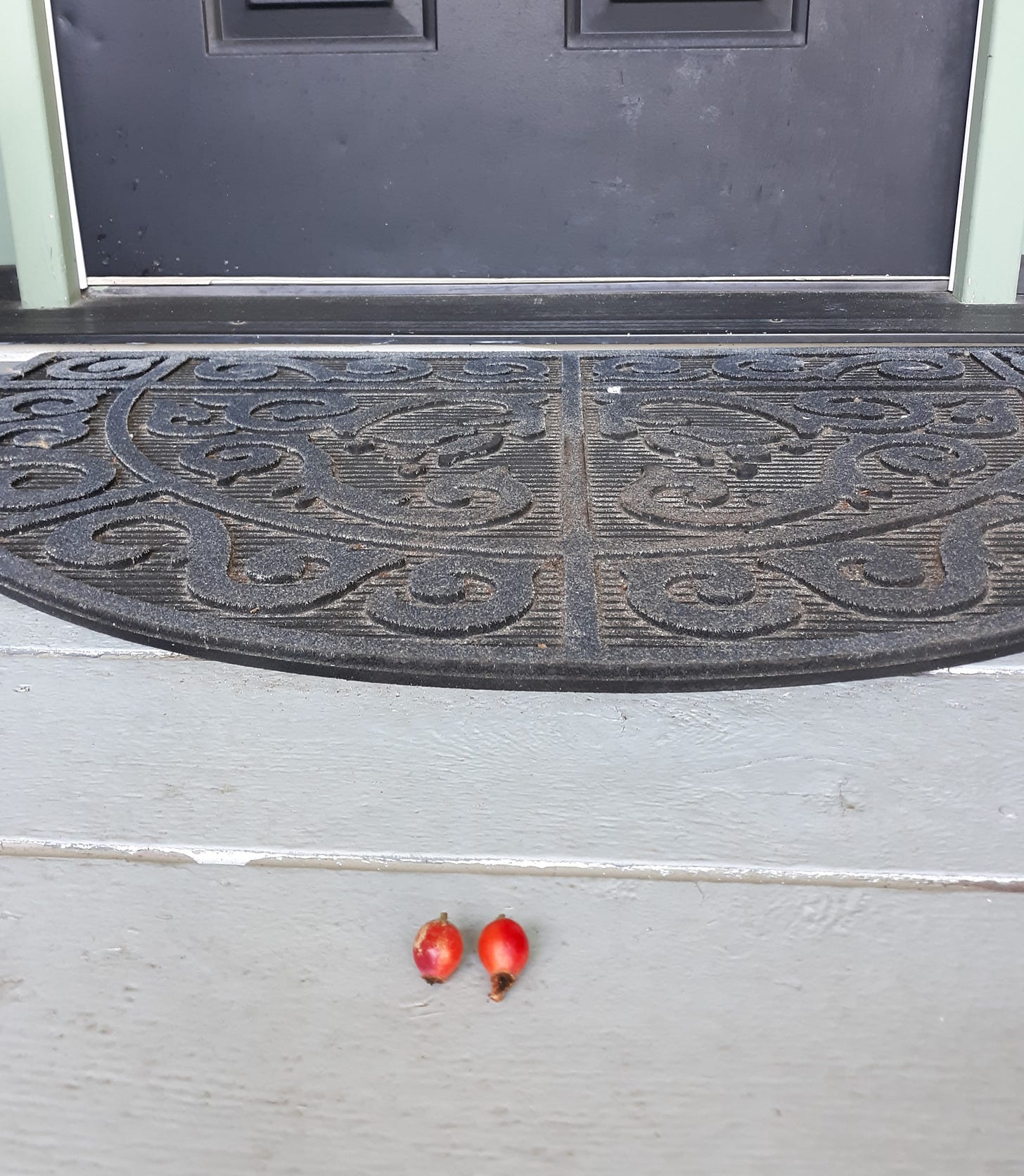Welcome! You’re at Mother E, a newsletter telling the stories about the connections between us and other species in a changing world.
Did you miss the last post? It’s here: What Happened on the Day Winter Turned Into Spring? You can find all posts here.
DURING THE HEIGHT OF THE PANDEMIC lockdown, I craved time outside, so I took my reading out onto our covered porch. One day, a local Common Raven who often flew in to bathe or drink from our fountain joined me. He (larger than several others, so probably a "he") splashed around in the fountain, throwing water over his back and rolling side to side.
Afterward, he companionably perched on the porch railing about a dozen feet away and groomed himself, napped, or gazed out into the forest for about 20 minutes while he had his after-bath dry off. I felt oddly soothed by the presence of another being enjoying the warm fall sun and trusting me enough to sit nearby. Maybe we were soothing each other, as I'm sure the raven, known for its intelligence, noticed the changes in the human world but may not have understood them.
A few days before that porch visit, I had bought a lingcod from a local fisherman for our dinner and left scraps of raw fish under our fruit trees for the wildlife. I noticed the local raven pair swooped down to get some. My husband occasionally catches mice in a trap and tosses them into the forest. He's seen the raven picking up one of these mice and flying off with it, doing its carrion-consumption service.
The visiting raven, whom we came to call "Bran," came regularly to use the fountain during the Fall of 2020 and helped to ease the isolation of pandemic lockdown. He has continued showing up to visit us and sometimes flies in with his mate, even curiously peering into our windows. Researchers say ravens are very observant and can identify individual human faces.
Ravens are territorial and they form long-term pair bonds, often mating for life— a life that can be 15 years or so in the wild. This raven is part of a mated pair who often roost at night in one of the tall trees nearby. They raised a single chick last year, who continued visiting with mom and dad even after it was full grown. It occasionally still perches near a parent and requests food, like a teen-aged boy who is always hungry.
Ravens are glossy-black birds from the Corvidae family, often referred to as Corvids. They are the largest of this group of perching or passerine birds, weighing as much as 3 pounds, and with a sturdy bill, strong build, and wedge-shaped tail. Crows are their smaller relative. The Corvid group includes crows, rooks, jays, magpies, nutcrackers, jackdaws, and over 100 other birds.
Can ravens plan for the future?
Ravens are known for their intelligence. I have watched a raven taking a round walnut from the ground, fly up to a pole near a road and drop the whole walnut into the street. After a car eventually ran over the tough walnut shell and cracked it open, the raven could then eat the walnut meat inside.
Corvids display remarkable intelligence for animals of their size and are among the most intelligent birds thus far studied. Specifically, members of the family have demonstrated self-awareness in mirror tests, and tool-making ability (e.g., crows and rooks), skills which until recently were thought to be possessed only by humans and a few other higher mammals. Their total brain-to-body mass ratio is equal to that of non-human great apes and cetaceans, and only slightly lower than that of humans. Wikipedia
A broken piece of pottery about three inches long showed up on our porch roof last year, visible to us from inside the house. I suspect the raven of putting it there, perhaps to use as a tool. Who else could have? A few months later it was gone.
Studies have shown that the common raven is capable of saving items of value that can be used later as tools or as goods for barter, behavior that strongly suggests that this bird has the ability to plan for a future when these items might be needed.
https://www.britannica.com/animal/raven
Raven group dates
Ravens love to play. Young ravens often group in flocks to socialize, play, and test their skills before pairing off later with mates.
I witnessed a contest or play session while on a coastal walk. Ravens are agile flyers, like hawks. Five of them were using the updraft of a coastal cliff on a windy day to drop-jump off the cliff, catch the updraft, then acrobatically circle to land on a boulder and repeat it. It looked like an exhilarating activity that brought them joy, plus they could practice their flying skills. It reminded me of children at a playground who just can't get enough of going on the slide or merry-go-round over and over.
They have been known to play and take part in elaborate social games. Documented group games follow "king of the mountain", or "follow the leader", patterns. Other play involves the manipulation, passing, and balancing of sticks. Corvids also take part in other activities, such as sliding down smooth surfaces. These games are understood to play a large role in the adaptive and survival ability of the birds. Wikipedia Corvidae
The gift at the front door
Ravens can do surprising things. One morning recently, I opened my front door to greet the day and almost stepped on something placed squarely in front of the doormat. What were two orange-red rose hips doing neatly placed side-by-side in front of the door? They couldn't have blown or dropped there since there had been no wind and the porch had a roof over it.
I was puzzled and almost kicked them away before it hit me—the raven who frequently visits the porch had put them there. To confirm, I checked the railing in front of the rose bush where there were dozens of red rose hips. Sure enough, there was a fresh, wet raven dropping on the railing, a place I had not seen him before since the long branches tend to discourage perching.
I had heard that ravens occasionally left objects for people they knew well, a behavior that conservation ecologist Professor John Marzluff at the University of Washington, calls "gifting." It's documented that ravens favor things that are round and bright. Don't we all give presents that we like too? This present seemed special. It was colorful and carefully clipped off at the stem. There are two of us living here and there were two rose hips. Can ravens count or determine quantities of things? Studies say yes, in low numbers.
The raven had a desire to share something or show gratitude specifically offered to us, as the front door is where we usually enter and exit the house. Gratitude is not an emotion we usually associate with wild animals or birds, although animals share many of the same emotions as humans, as anyone who has ever lived closely with pets will acknowledge.
We like to think of ourselves as special, but whatever the difference between humans and animals may be, it is unlikely to be found in the emotional domain. Frans de Waal, primatologist and professor of psychology at Emory University
This gift showed me that we have much to learn about wild species and their inner lives. Maybe the raven was demonstrating a tradition called "reciprocity", or responding to a positive action with another positive action, giving back to others who have shown kindness or favor. Whatever the motive for the gift, it was also a demonstration of planning and interacting with another species on a deeper level.
Opportunistic feeders—sure, I'll eat that
One of the reasons ravens now live in many areas of the world is their adaptability and the fact that their diet is omnivorous and flexible. They eat carrion as well as rodents, grains, worms, insects, reptiles, bird eggs, and scavenged people's food.
Here on the coast, they can be a menace to shorebirds, as they may raid nests and steal their eggs to eat seasonally. Since they are intelligent and opportunistic, like humans, they can have a negative impact on some bird populations.
I have seen ravens flying with pieces of food in their beaks, maybe sharing it with others or taking it to stash somewhere. They are scavengers and have dropped someone else's spaghetti noodles into our fountain. My husband has seen them scratching in the dirt and burying food for later retrieval—making a sort of raven pantry. Through their consumption of carrion, they provide an ecosystem service by recycling nutrients.
Raven legends among Northwest Indigenous people
Ravens developed on the earth millions of years ago. The earliest corvid fossils (precursors to crows and ravens) were found in Europe and dated back to about 17 million years ago.
Ravens' intelligence, adaptability, and scavenger habits mean that they have followed human populations, so older human cultures have a long association and history with ravens.
In North America ravens have been featured in creation myths, carved onto totem poles and clan groups have been named after them. Their brainpower and resilience were admired by many Indigenous peoples, who say ravens have "always" been here—an acknowledgment that birds such as ravens have millions of years more history on the earth than humans.
In the mythology of many Northwest Indian tribes, Raven is honored as a culture hero. He is a revered and benevolent transformer figure who helps the people and shapes their world for them, but at the same time, he is also a trickster character and many raven stories have to do with his frivolous or poorly thought out behavior causing trouble for him and the people around him. Raven is noted for negative traits such as gluttony, greed, and impatience as well as for his heroism and great deeds.
http://www.native-languages.org/legends-raven.htm
A trickster reputation follows ravens even to this day. Their keen observation makes them notice things much more than most of us. Researchers have heard ravens, with their wide vocal skills, imitate chain saws, other birds, cars, even voices.
Play is an important element in their lives, and watching ravens reminds me to balance work with play, for play is how we try out new skills, engage with others and rejuvenate ourselves.
Northwest Indigenous lore considers Ravens to be creatures of metamorphosis, who symbolize change and transformation. That could make them a symbol of our times. We are in a unique decade now with the climate crisis and rapid Earth changes. A transformation of how we humans live on Earth is underway and necessary for our survival.
I will end by sharing a creation myth from multiple Northwest Native peoples: the Tlingit, Tahltan, and Haida among others. This tale (recounted in the video below) tells how Raven stole the light of the world (sun, moon, and stars) from an old man who was keeping the world dark by hoarding light in a box. Raven used trickery, stealing it away and releasing it into the world. Bringing light to the world is quite a legacy for this unique ebony-black bird to carry.
More facts about ravens from The Cornell Lab
Want to see the ravens in action?
Here's a video of wild ravens below from Rick Boufford at The Raven Diaries. This is a longer YouTube video (16 minutes) with close-ups of raven pairs, acrobatic flying, and other raven facts. It's visually beautiful and shows 5 unique things ravens do.






Tree Mercer shared her raven story with me by email.
"We have a mated pair of ravens that have been visiting us everyday as we sit on the cliff at the Lighthouse searching for whales. This has occurred for the past eight years and we have seen them build their nest, raise their young, and do all sorts of amazing things! They actually recognize our van as we drive down Lighthouse Road and
they escort us to our parking spot! Their intelligence and loyalty just blow me away.
We have very affectionately named them Barry and Michelle." Tree Mercer
Marion Patterson of Anchor Bay shared this amazing raven story with me.
"My friend in Yosemite heard a screaming and banging on pans at a neighbor’s cabin. She investigated and found the mean old Mrs. XXX was trying to scare off a raven. She said the ravens were stealing nails from her roof. The offending raven took off and soon returned, swooped down, and dropped a very live snake right on Mrs XX’head. Bulls eye! Moral: never mess with a raven."